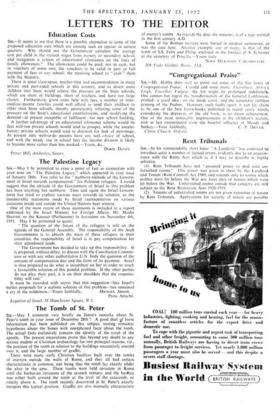The Tomb of St. Peter
SIR,—May I comment very briefly on Janus's remarks about St. Peter's tomb in your issue of December 28th ? A good deal vf loose information has been published on this subject, mixing. romantic hypotheses about the bones with unexplained facts about the tomb. The actual facts exclusively concern the identity of the tomb of the apostle. The present excavations prove this beyond any doubt to any serious student of Christian archaeology for two principal reasons, viz., the position of the tomb in relation to the buildings successively erected over it, and the latge number of graffiti.
There were many early Christian basilicas built over the tombs of martyrs outside the walls of Rome, and they all had certain characteristics in common, one being that the tomb lay exactly under the altar in the apse. These tombs were held inviolate in Rome until the barbarian invasions of the seventh century, and the bastica was either built around the tomb at the level of the catacomb, or exactly above it. The tomb recently discovered at St. Peter's exactly occupies this typical position. Graffiti are also normally characteristic of martyr's tombs. As regards the date, the masonry is of a type normal in the first century A.D.
Some of the Roman martyrs were buried in outdoor cemeteries, as was the case here. Another example, out of many, is that of the tomb of S.S. Felix and Philip, enclosed in the basilica of S. Sylvester at the cemetery of Priscilla.—Yours truly,
NORA DICKINSON CARLODALATRI.
208 Viale Giolitti, Rome, I3A.


































 Previous page
Previous page